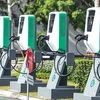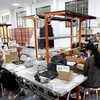The Ministry of Finance has announced a pilot scheme to allow 200 firms in Hanoi and Ho Chi Minh City to use electronic invoices late this year, the Saigon Times Daily reported.
According to the newspaper, the electronic bill will be provided with authentication code and number by the taxman.
The authentication code and number are character strings which are encoded and provided by an authentication system based on billing information of goods or services.
Besides, a QR code will be added in the upper right corner of the invoice. Users can scan this two-dimensional barcode to read and check the information by electronic devices installed with QR code reader software such as a smartphone.
The finance ministry highly evaluated this new type of invoice for its security and economy. The electronic bill will reduce expenses for printing and storing, as well as the inconvenience for businesses and tax authorities.
The service also has the advantage of being available around the clock, including holidays. Therefore, businesses can issue invoices continuously to ensure smooth operation.
The newspaper said that a representative of the finance ministry affirmed electronic bills authenticated by tax authorities have full legal validity as other legal ones. However, enterprises must use specific software to issue and authenticate invoices.
Businesses can issue invoice by the free software ICA offered by the General Department of Taxation, their own LHD which allows users to issue and print out invoices, or the invoice processing software VAN which includes the issuing function.
After issuing an invoice by one of the three above-mentioned ways, representatives of companies will sign and send the invoices to VAN of the taxman for processing. VAN will exchange the information with the authentication software ICC and take back the authenticated invoices.
In addition, businesses and tax authorities can look up and check for authenticated invoices with ICE software.-VNA
According to the newspaper, the electronic bill will be provided with authentication code and number by the taxman.
The authentication code and number are character strings which are encoded and provided by an authentication system based on billing information of goods or services.
Besides, a QR code will be added in the upper right corner of the invoice. Users can scan this two-dimensional barcode to read and check the information by electronic devices installed with QR code reader software such as a smartphone.
The finance ministry highly evaluated this new type of invoice for its security and economy. The electronic bill will reduce expenses for printing and storing, as well as the inconvenience for businesses and tax authorities.
The service also has the advantage of being available around the clock, including holidays. Therefore, businesses can issue invoices continuously to ensure smooth operation.
The newspaper said that a representative of the finance ministry affirmed electronic bills authenticated by tax authorities have full legal validity as other legal ones. However, enterprises must use specific software to issue and authenticate invoices.
Businesses can issue invoice by the free software ICA offered by the General Department of Taxation, their own LHD which allows users to issue and print out invoices, or the invoice processing software VAN which includes the issuing function.
After issuing an invoice by one of the three above-mentioned ways, representatives of companies will sign and send the invoices to VAN of the taxman for processing. VAN will exchange the information with the authentication software ICC and take back the authenticated invoices.
In addition, businesses and tax authorities can look up and check for authenticated invoices with ICE software.-VNA



















